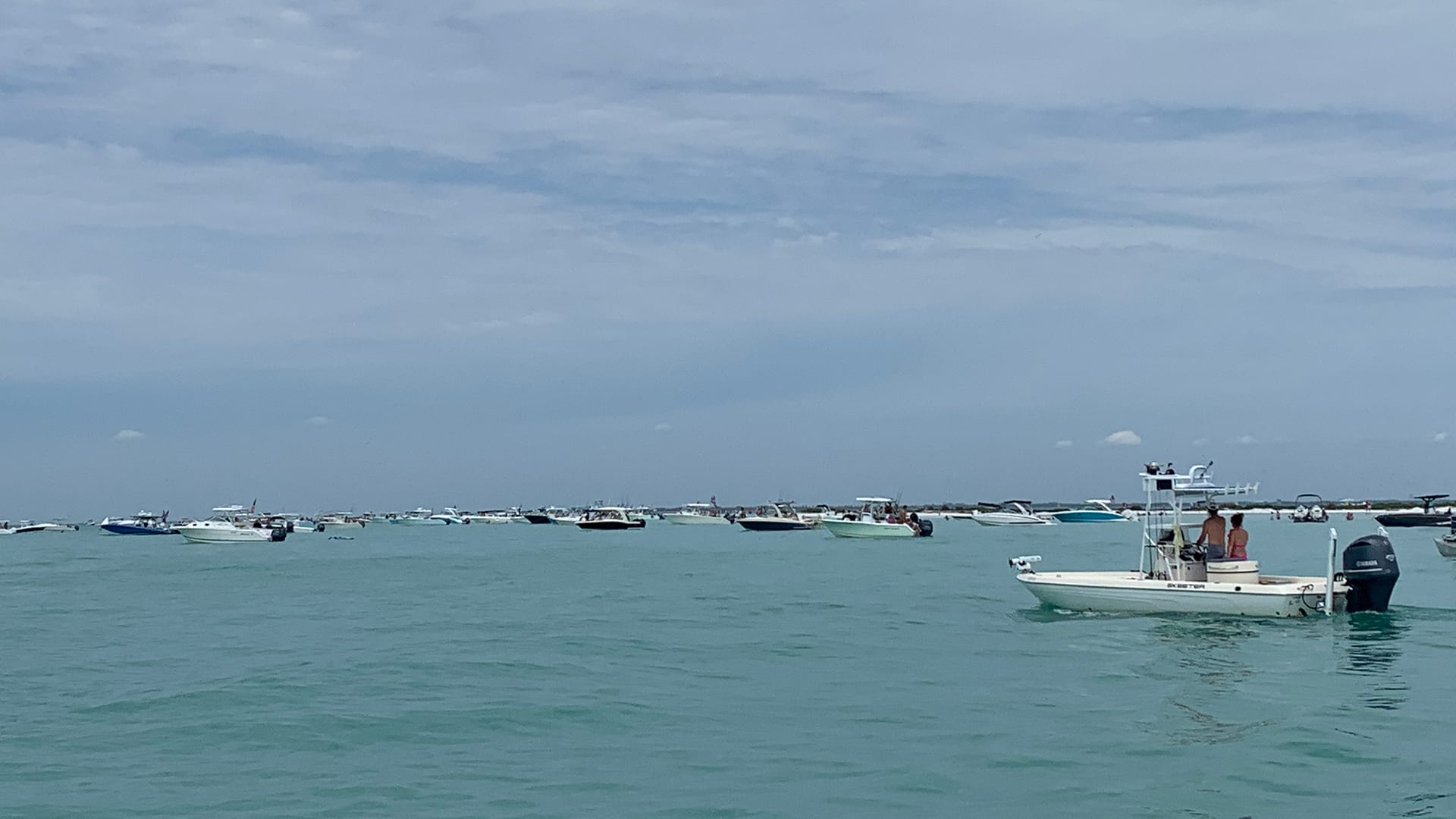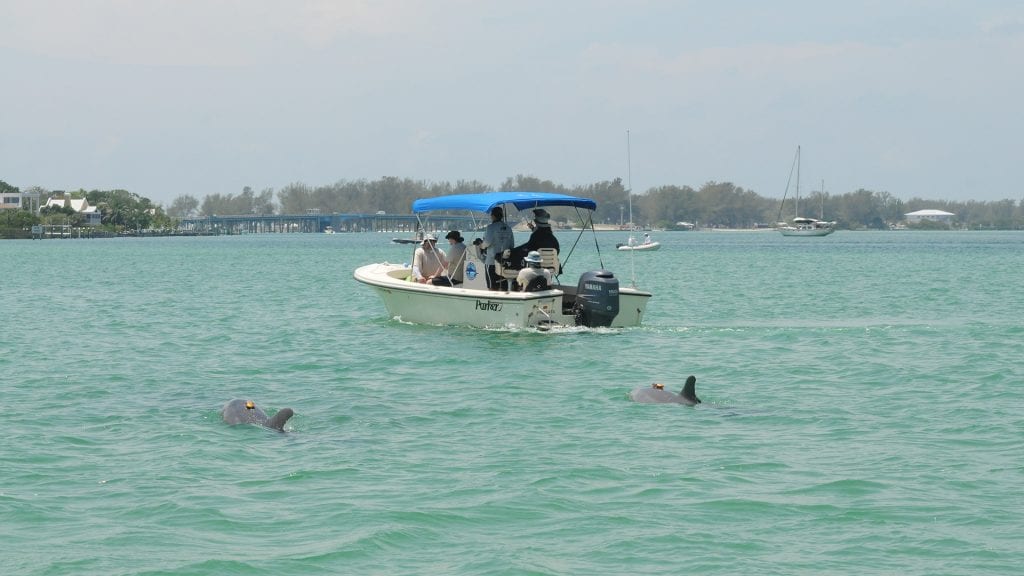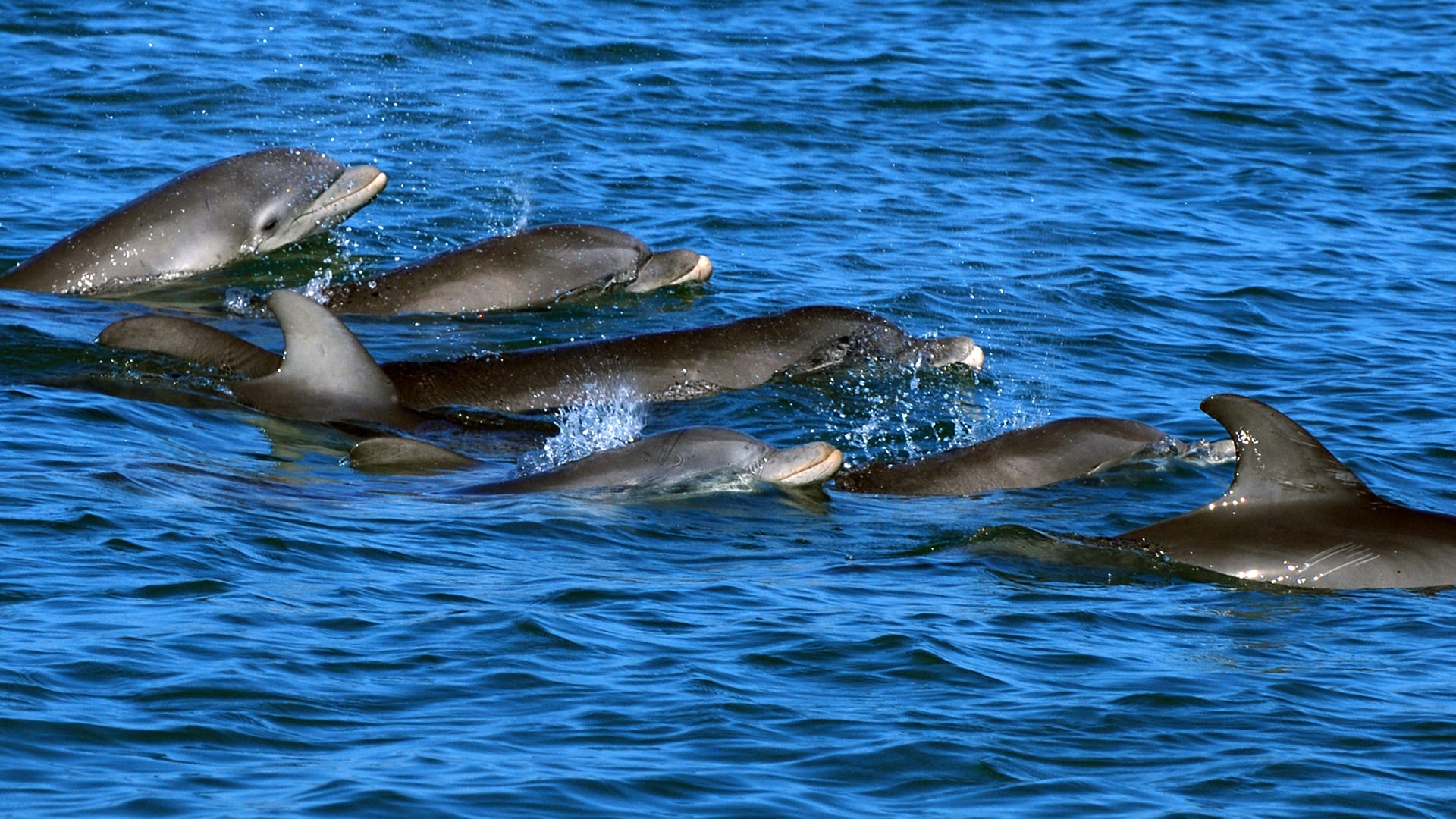Bottlenose dolphins continue to compensate for humans in spite of pandemic
By Daniel Hentz | June 10, 2020
Recreational boats gather by Passage Key at the mouth of Sarasota Bay in Florida, a now common scene on weekends during the pandemic. (Photo courtesy of Randall Wells)

Though vessel noise may have quieted down on the high seas, one coastal area in Florida is seeing an upswing in boat traffic according to local authorities, putting more pressure on the world’s longest-studied wild bottlenose dolphin community.
Since the start of the pandemic, scientists have been jumping at the opportunity to study the effects of a quieter marine environment. But not every part of the ocean is experiencing the same kind of zen. In Sarasota, Florida, marine police officers have reported significant increases in boat traffic over the course of the last few months, as coastal residents look for new ways to reduce ennui during stay-at-home orders.
“Now, when people are underway going to their destinations, they’re coming at you, behind you, and crossing in front of you,” says one anonymous officer from the Sarasota Marine Patrol unit. “The bay looks like a washboard, all churned up from everybody’s wakes. You’ve got kayakers that are trying to cross channels, swimmers trying to make it out to sandbars, then you’ve got manatees and dolphins in the mix…It’s a miracle there aren’t more vessel strikes.”
While resident bottlenose dolphins in Sarasota are conditioned to evade boat traffic, recent findings from scientists at WHOI show that even though dolphins have ways of compensating for the increasing noise, the activity may still be disrupting vital communication between the animals.
“Dolphins are highly acoustic animals and they depend on sound for both communication as well as biosonar-based foraging,” says Frants Jensen, a marine behavioral ecologist at the institution. “Using sound and movement recording tags that capture the noise experienced by the animals themselves, we are trying to understand how all this could interrupt communication and foraging behaviors, and how animals cope with it.”
Jensen, along with WHOI researchers Laela Sayigh and Peter Tyack, has been collaborating with scientists from the Chicago Zoological Society’s Sarasota Dolphin Research Program to study how underwater noise impacts dolphins in the area. With their help, he's managed to tag scores of animals with acoustic recorders to monitor their behavior and auditory responses to vessel activity. After eight years, and 222 hours of audio recordings, those data evidence a clear trend: bottlenose dolphins are steadily raising the volume of their whistles to compensate for the increase in boat traffic noise.
Known as the Lombard response, named after French ear surgeon Étienne Lombard who discovered the phenomenon in 1909, the reflex of raising one’s volume to compensate for background noise is common in most mammals. If you’ve ever gone to a rock concert, construction site, or a club, for example, you may have done this to get a friend’s attention. To live like a Sarasotan bottlenose dolphin, however, would be like trying to communicate in the middle of a non-stop block party.
Before the pandemic, Jensen says boat traffic had more than tripled since the dolphin research program began in the 1970s.
“On average, a dolphin swimming through Sarasota Bay will be passed by a boat within 100 meters every six minutes during the day; in some areas the rate is even higher," he adds.
Unlike other findings, which suggest whales and their relatives can compensate decibel-for-decibel of ocean noise, Jensen’s study shows bottlenose dolphins can only partially amplify their voices. And while this ability could be considered an example of the animal's resilience amid heavy boat traffic, Jensen notes it's also a physiological limitation.
“Dolphins use higher amplitude signature whistles to maintain or regain contact with one another,” he notes. “[So] it’s hard to turn up the volume when you’re already yelling.”
For a species used to making its voice heard, augmenting already loud whistles is a challenge. But if Sarasota’s history is any indication, the underwater ruckus may only worsen in time—something Jensen’s collaborators say could increase the species’ reliance on human intervention to survive.
You can hear how boats disrupt dolphin communication in the audio clip below by clicking the microphone on the bottom left.
The sounds of bottlenose dolphin whistles are powerful and far-reaching, but are they enough to compete with the noise of speed boats? (Audio courtesy of Frants Jensen, © Woods Hole Oceanographic Institution)
A model community
Fifty years ago, Sarasota Bay was relatively obscure to the world of marine mammal research. Back then, dolphin studies were early days—some with truly ambitious objectives.
In 1970, the Office of Naval Research provided funding to Mote Marine Laboratory—the country's preeminent shark research facility—to investigate the possibility of using dolphins to keep sharks away from scientific divers. In their spare time, the project's lead researcher Blair Irvine and his assistant Randy Wells began tagging local dolphins to study their movements. It didn't take long before the two discovered something interesting about the bay's animals.
After relatively little time, the two noticed the same marked animals reappearing over and over. With no prior systematic study of the species' ranging patterns (where and how far individuals go), Irvine and Wells were shocked. The bottlenose had true residency in these inshore waters. By 1974, a more intensive study of the dolphins in Sarasota Bay had begun in earnest.
“The dolphins of Sarasota Bay are unique in terms of how long they’ve been studied,” says Wells, a former WHOI postdoc, now the Director of the Sarasota Dolphin Research Program for the Chicago Zoological Society. “We’ve been able to document the daily lives and dramas that individuals within the resident lineages have had to go through over time.”
Since these initial findings, research studies have expanded in the Bay––many piggy-backing off of the Sarasota program’s periodic health assessments. Jensen, for example, used the opportunity to attach temporary suction-cup computer tags to the backs of dozens of individuals over the years. Other experiments, including those by Sayigh and Tyack, crucially advanced our understanding of signature whistles, a dolphin’s auditory thumbprint.
Almost half a century after his initial observations, Wells says he and his colleagues are able to readily identify over 95% of the more than 170 resident individuals, from their distinct fin notches to their charismatic behaviors. They’ve gotten so good, he adds, that his coworkers have memorized the pedigree of each animal, in some cases spanning five living generations.
“We can go out on a regular basis and find well-known, long-term resident dolphins… we know their age, sex, who they socialize with, et cetera,” says Wells proudly.
Dolphin #FB54
In the time that the Sarasota Dolphin Research Program has been running, the county’s population has skyrocketed from roughly 120,000 to over 433,000 people–––boat ownership has grown in kind. Senior bottlenose dolphins still on record have been alive for much of that change.
The oldest, FB54, has been around to watch boat activity soar, while the advent of shallower draught designs in the 1980s allowed pontoons, skiffs, and high speed vessels to explore deeper into Sarasota’s many inlets. Over time, that has meant less refuge for her and her calves. In effect, dodging boats has become a new learned behavior for the species to survive.
“I don’t think people fully appreciate what these animals have to go through,” says Wells. “They have to face their normal predators, find food, deal with social interactions…[and] now humans put into the mix a lot of other things they have to contend with.”

A pair of allied bottlenose dolphin males (IDs F276 and F142) instrumented with sound and movement recording DTAGs surface next to a Chicago Zoological Society research vessel. (Photo courtesy of Frants Jensen, © Sarasota Dolphin Research Program)
Among the natural pressures that may have been exacerbated by humans are things like harmful algal blooms, which kill much of the fish that bottlenose like to prey on. Add to that entanglements from fishing gear, dodging boats, and the extreme amount of underwater noise, and you begin to get a clear picture of the gauntlet this community must run on a daily basis.
Recreational boats happen to be more disruptive to dolphins than larger vessels because of their smaller, faster propellers. At high enough speeds, the popping of thousands of tiny bubbles—a phenomenon known as cavitation—can create a high-pitch frequency in direct conflict with the dolphin’s squeaky patois.
Knowing this, Jensen feels the steps to help decrease the impact of noise on dolphins may be easier and more cost-effective than installing quieter propellers.
"The simplest way people can help decrease impacts of noise on dolphins is to slow down when they are out boating,” he says. “This drastically reduces high frequency noise from cavitation, and it has the added benefit of reducing collisions with manatees. So slow down and take a bit more time to enjoy the ride."
Until such a time that laws can enforce boat activity in certain areas of the Bay, the onus will be on boat owners to better regulate their speed. Whether they choose to do so remains to be seen.
Still, the region continues to be a paradigm for similar dolphin communities around the world. Like many apex predators, the bottlenose’s decline could bring major changes to coastal ecosystems and their fisheries without another top predators to help balance the food chain.
That’s one of the reasons Wells and his staff continue with their monthly surveys in Sarasota Bay, while following strict social distancing measures. Ultimately, the uptick in boat activity from the pandemic may just be a glimpse at the broader trajectory human-dolphin interactions are hurtling towards.
“No matter what threat humans are prioritizing at any given time, it doesn’t necessarily take away the existing environmental threats that are out there,” says Wells. “We’ve come to appreciate that the smile on [a dolphin’s] face is anatomy, it’s not attitude.”
FB54 has been spotted 1,492 times. Wells hopes to see her again.

The fieldwork referenced in this story was carried out under National Marine Fisheries Service Scientific Research Permit no. 15543 to R. S. Wells and with IACUC approvals through Woods Hole Oceanographic Institution, Mote Marine Laboratory and the University of St Andrews Animal Welfare and Ethics Committee. This research would not have been possible without support from the Grossman Foundation, the Office of Naval Research, Dolphin Quest, Inc., and Woods Hole Oceanographic Institution.
